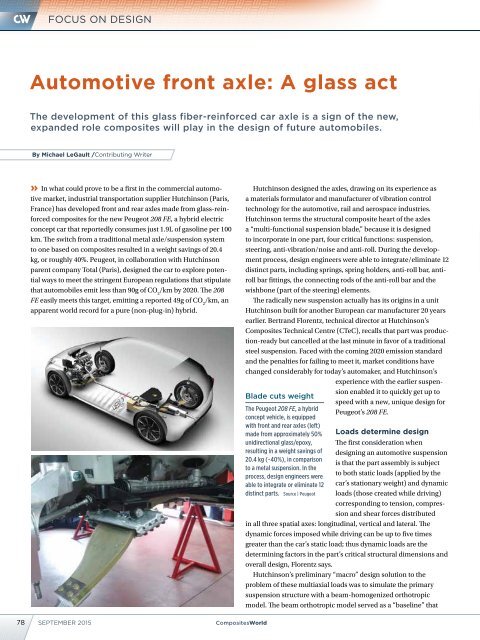FOR AUTO RTM
1VeKpGy
1VeKpGy
Create successful ePaper yourself
Turn your PDF publications into a flip-book with our unique Google optimized e-Paper software.
FOCUS ON DESIGN<br />
Automotive front axle: A glass act<br />
The development of this glass fiber-reinforced car axle is a sign of the new,<br />
expanded role composites will play in the design of future automobiles.<br />
By Michael LeGault /Contributing Writer<br />
» In what could prove to be a first in the commercial automotive<br />
market, industrial transportation supplier Hutchinson (Paris,<br />
France) has developed front and rear axles made from glass-reinforced<br />
composites for the new Peugeot 208 FE, a hybrid electric<br />
concept car that reportedly consumes just 1.9L of gasoline per 100<br />
km. The switch from a traditional metal axle/suspension system<br />
to one based on composites resulted in a weight savings of 20.4<br />
kg, or roughly 40%. Peugeot, in collaboration with Hutchinson<br />
parent company Total (Paris), designed the car to explore potential<br />
ways to meet the stringent European regulations that stipulate<br />
that automobiles emit less than 90g of CO 2<br />
/km by 2020. The 208<br />
FE easily meets this target, emitting a reported 49g of CO 2<br />
/km, an<br />
apparent world record for a pure (non-plug-in) hybrid.<br />
Blade cuts weight<br />
The Peugeot 208 FE, a hybrid<br />
concept vehicle, is equipped<br />
with front and rear axles (left)<br />
made from approximately 50%<br />
unidirectional glass/epoxy,<br />
resulting in a weight savings of<br />
20.4 kg (~40%), in comparison<br />
to a metal suspension. In the<br />
process, design engineers were<br />
able to integrate or eliminate 12<br />
distinct parts. Source | Peugeot<br />
Hutchinson designed the axles, drawing on its experience as<br />
a materials formulator and manufacturer of vibration control<br />
technology for the automotive, rail and aerospace industries.<br />
Hutchinson terms the structural composite heart of the axles<br />
a “multi-functional suspension blade,” because it is designed<br />
to incorporate in one part, four critical functions: suspension,<br />
steering, anti-vibration/noise and anti-roll. During the development<br />
process, design engineers were able to integrate/eliminate 12<br />
distinct parts, including springs, spring holders, anti-roll bar, antiroll<br />
bar fittings, the connecting rods of the anti-roll bar and the<br />
wishbone (part of the steering) elements.<br />
The radically new suspension actually has its origins in a unit<br />
Hutchinson built for another European car manufacturer 20 years<br />
earlier. Bertrand Florentz, technical director at Hutchinson’s<br />
Composites Technical Centre (CTeC), recalls that part was production-ready<br />
but cancelled at the last minute in favor of a traditional<br />
steel suspension. Faced with the coming 2020 emission standard<br />
and the penalties for failing to meet it, market conditions have<br />
changed considerably for today’s automaker, and Hutchinson’s<br />
experience with the earlier suspension<br />
enabled it to quickly get up to<br />
speed with a new, unique design for<br />
Peugeot’s 208 FE.<br />
Loads determine design<br />
The first consideration when<br />
designing an automotive suspension<br />
is that the part assembly is subject<br />
to both static loads (applied by the<br />
car’s stationary weight) and dynamic<br />
loads (those created while driving)<br />
corresponding to tension, compression<br />
and shear forces distributed<br />
in all three spatial axes: longitudinal, vertical and lateral. The<br />
dynamic forces imposed while driving can be up to five times<br />
greater than the car’s static load; thus dynamic loads are the<br />
determining factors in the part’s critical structural dimensions and<br />
overall design, Florentz says.<br />
Hutchinson’s preliminary “macro” design solution to the<br />
problem of these multiaxial loads was to simulate the primary<br />
suspension structure with a beam-homogenized orthotropic<br />
model. The beam orthotropic model served as a “baseline” that<br />
78 SEPTEMBER 2015<br />
CompositesWorld


